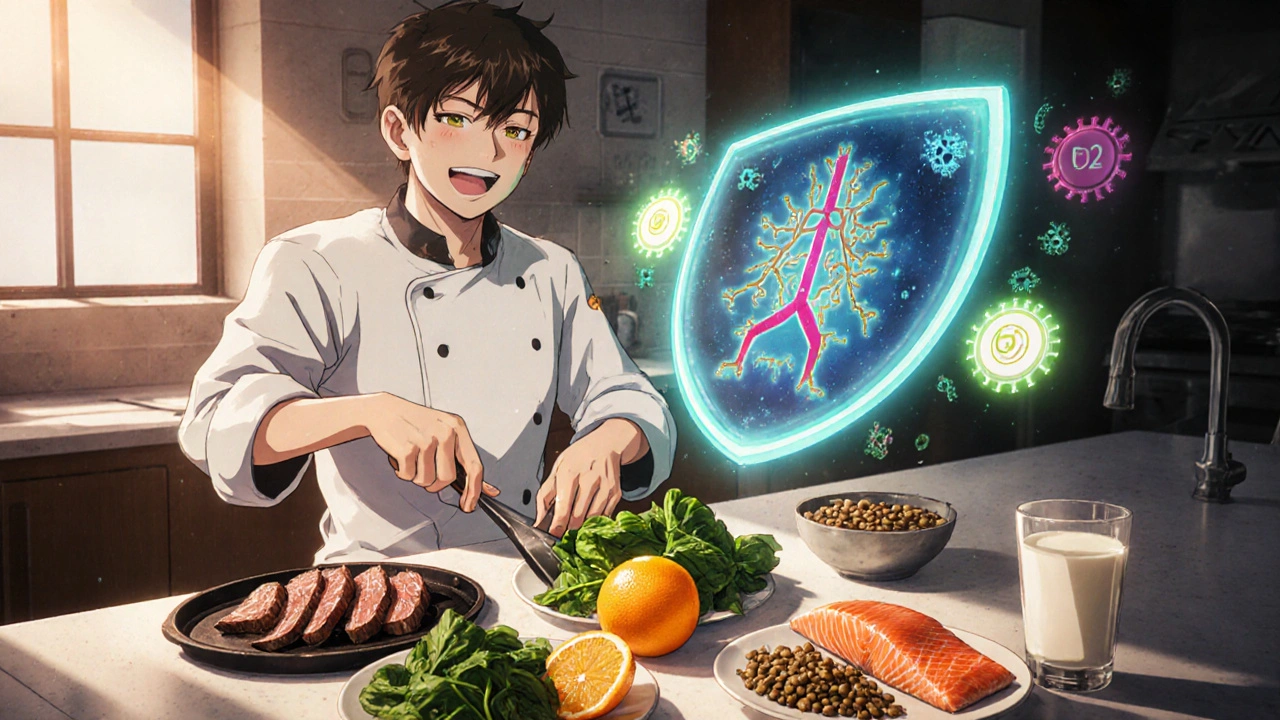Nutritional Anemia Risk Calculator
Nutrient Intake Assessment Tool
This tool estimates your daily intake of iron, vitamin B12, and folate based on your dietary choices. It helps identify potential nutrient deficiencies that may weaken your immune system and increase infection risk.
When you hear the term nutritional anemia, you might wonder how a simple lack of nutrients can make you more vulnerable to infections. Nutritional anemia is a type of anemia that occurs when the body doesn’t get enough iron, vitamin B12, folate, or other key nutrients needed to produce healthy red blood cells. In this article we’ll walk through why these deficiencies matter, how they sabotage your immune system, and what practical steps you can take to stay resilient.
What Exactly Is Nutritional Anemia?
At its core, anemia means you have fewer red blood cells or less hemoglobin than normal. Hemoglobin, the iron‑rich protein that carries oxygen, is essential for every cell to function. When nutrition falls short, the bone marrow can’t keep up, leading to fatigue, breathlessness, and-crucially-a weakened defense against pathogens.
Key Nutrients Behind the Condition
Three nutrients are responsible for the vast majority of nutrition‑related anemias. Below we unpack each one, why the body needs it, and what happens when it’s missing.
Iron
Iron is a mineral that forms the core of the hemoglobin molecule, enabling oxygen transport in the blood. Without enough iron, the body produces smaller, paler red cells-a classic picture of iron‑deficiency anemia. Common signs include restless legs, brittle nails, and a craving for ice. Infections thrive when iron levels dip because the immune cells lose the energy needed for rapid response.
Vitamin B12
Vitamin B12 is a water‑soluble vitamin crucial for DNA synthesis and the maturation of red blood cells. Deficiency often stems from poor animal‑product intake or malabsorption disorders such as pernicious anemia. Low B12 not only reduces red cell count but also impairs the production of myelin, the protective sheath around nerves, leading to neurological symptoms that can mask infection signs.
Folate (Vitamin B9)
Folate is a B‑vitamin needed for cell division and the synthesis of nucleic acids. Pregnant women, people on certain anti‑seizure meds, and those with alcohol dependence are particularly at risk. Folate deficiency produces a macrocytic anemia-large, immature red cells-that hampers oxygen delivery and slows the immune response.
How Anemia Undermines the Immune System
The immune system relies on two main fronts: innate defenses (like white blood cells and cytokines) and adaptive defenses (antibodies and T‑cells). Nutritional anemia throws a wrench into both.
White blood cells are the cellular troops that hunt down bacteria, viruses, and fungi. Their production, known as leukopoiesis, draws heavily on iron and B12. When red blood cells are scarce, the bone marrow deprioritizes white cell formation, leaving you with fewer soldiers on the frontline.
Cytokines are signaling proteins that coordinate inflammation and direct immune cells to infection sites. Iron deficiency blunts cytokine release, meaning inflammation is slower and less targeted. The result? Pathogens get a bigger window to multiply.
Even the production of Hemoglobin the oxygen‑binding protein inside red blood cells matters. Low hemoglobin means tissues-including lymph nodes and spleen-receive less oxygen, impairing the metabolic firepower immune cells need to proliferate.

Clinical Evidence: Anemia Increases Infection Susceptibility
Several epidemiological studies have quantified the link. A 2023 cohort of 12,000 adults in the UK found that individuals with iron‑deficiency anemia were 1.8 times more likely to be hospitalized for pneumonia compared to iron‑replete peers. Another 2022 meta‑analysis of 34 trials showed that vitamin B12 supplementation reduced the incidence of urinary tract infections by 22 % in elderly patients.
These numbers aren’t just academic-they reflect real‑world consequences. Children with folate‑deficiency anemia are more prone to severe diarrheal disease, while immunocompromised patients often see a flare‑up of opportunistic infections after a bout of anemia.
Prevention and Dietary Strategies
Fixing the problem starts with food, not pills (unless a doctor recommends supplementation). Below is a practical guide to keep the three key nutrients in check.
- Iron: Include lean red meat, poultry, lentils, and fortified cereals. Pair plant‑based iron with vitamin C‑rich foods (citrus, bell peppers) to boost absorption.
- Vitamin B12: Aim for eggs, dairy, fish, and fortified nutritional yeast. Vegans should consider a B12 supplement of 25‑100 µg daily.
- Folate: Load up on dark leafy greens, beans, and citrus fruits. Women of childbearing age should target at least 400 µg of dietary folate each day.
Don’t forget hydration and a balanced gut. Gut microbiota the community of microbes residing in the intestines that help synthesize certain B‑vitamins thrive on fiber and fermented foods, indirectly supporting your nutrient status.
Quick Checklist: Spotting Nutritional Anemia Early
- Persistent fatigue or weakness despite adequate sleep.
- Pale skin, especially on the inner eyelids.
- Shortness of breath during mild activity.
- Frequent infections or slower wound healing.
- Glossy or smooth tongue, and unusual cravings (e.g., ice, non‑food items).
- Recent dietary changes, restrictive diets, or gastrointestinal symptoms.
If you tick three or more, schedule a blood test for hemoglobin, ferritin, serum B12, and folate levels. Early detection lets you correct the deficiency before infections take hold.

Putting It All Together: A Sample Daily Meal Plan
Here’s a day‑long menu that hits the three nutrient targets without feeling forced.
- Breakfast: Greek yogurt with blueberries, a sprinkle of fortified cereals, and a glass of orange juice (vitamin C boosts iron).
- Mid‑morning snack: A boiled egg and a handful of almonds.
- Lunch: Spinach and quinoa salad with grilled salmon, chickpeas, and a lemon‑tahini dressing.
- Afternoon snack: Carrot sticks with hummus (more iron) and a piece of dark chocolate.
- Dinner: Stir‑fried beef strips with broccoli, bell peppers, and brown rice; finish with a cup of fortified soy milk.
This plan provides roughly 18 mg of iron, 5 µg of B12, and 400 µg of folate-enough to keep most adults in the safe zone.
Frequently Asked Questions
Can I get nutritional anemia from a vegetarian diet?
Yes. Plant‑based diets can be low in highly bioavailable iron and vitamin B12. Vegans should focus on fortified foods and consider a B12 supplement, while vegetarians can include eggs, dairy, and iron‑rich legumes paired with vitamin C.
Does anemia always cause infections?
Not every case leads to infection, but anemia markedly lowers the odds of fighting off pathogens quickly. The risk rises especially when anemia is severe or combined with other immune‑compromising conditions.
How quickly can supplementation restore immune function?
Iron stores may take 2‑3 months to rebuild, while B12 and folate levels can normalize within weeks. Most people notice an energy boost and fewer sick days after the first month of consistent intake.
Are there risks to taking iron supplements without a deficiency?
Yes. Excess iron can cause gastrointestinal upset and, over time, may increase oxidative stress. Always get a blood test before starting high‑dose iron.
What lab tests confirm nutritional anemia?
Key tests include complete blood count (CBC), serum ferritin, serum iron, total iron‑binding capacity (TIBC), vitamin B12 level, and folate (serum or red‑cell folate).
Bottom Line
When your blood lacks the right nutrients, it’s not just a matter of feeling tired-your whole immune army is on a slow‑poke schedule. By recognizing the signs, testing early, and loading up on iron, vitamin B12, and folate, you give your body the tools it needs to fend off everyday bugs. Stay proactive, keep an eye on your diet, and you’ll keep infections at bay.
| Nutrient Deficiency | Typical Lab Findings | Infection Risk Impact | Key Food Sources |
|---|---|---|---|
| Iron | Low ferritin, low transferrin saturation, microcytic hypochromic RBCs | Reduced neutrophil oxidative burst, higher pneumonia rates | Red meat, lentils, fortified cereals, spinach + vitamin C |
| Vitamin B12 | Low serum B12, elevated methylmalonic acid, macrocytic RBCs | Impaired DNA synthesis in white cells, slower antibody response | Eggs, dairy, fish, fortified plant milks, supplements |
| Folate (B9) | Low serum folate, macrocytic RBCs, normal B12 | Less robust lymphocyte proliferation, higher GI infection rates | Leafy greens, beans, citrus, fortified grains |


Stephen Wunker
October 22, 2025 AT 05:26Most people think more iron in their diet is just a boring health tip, but the reality is that the medical establishment is selling us a complacent narrative.
They pat you on the back for a multivitamin while the hidden costs of an over‑industrialized food system remain invisible.
If you look at the data, the immune suppression linked to iron deficiency is a symptom of a larger societal neglect of true nutrition.
We are told that anemia is merely a tiredness issue, yet it silently disarms our cellular army.
Every time you cough up a cold, consider whether your red blood cells are too weak to carry oxygen to the fighting troops.
Iron isn’t just a mineral; it’s the backbone of hemoglobin, the very engine that powers your immune response.
When iron levels dip, the bone marrow shifts priorities, sidelining white blood cell production.
This shift isn’t a temporary glitch; it’s a systemic weakness that can linger for months.
Vitamin B12 and folate have the same effect on the DNA replication machinery, meaning a deficiency can cripple the whole defense network.
It’s not enough to eat a steak once a week; you need a consistent supply of bioavailable nutrients.
The body doesn’t forgive sporadic intake the way it forgives occasional lapses in sleep.
For most of us, the modern diet is a minefield of absorption inhibitors that sabotage even the best intentions.
Phytates in grains, tannins in tea, and calcium overload can all block iron uptake, turning a seemingly rich plate into a nutrient desert.
So before you blame a bad flu on bad luck, examine the silent sabotage happening at the cellular level.
Only by confronting these hidden deficiencies can we truly fortify our immune arsenal.
Jhoan Farrell
October 26, 2025 AT 20:33Whoa, the connection between anemia and infection risk really hits home-feeling constantly wiped out can be scary 😟. Keeping an eye on iron, B12, and folate isn’t just about energy; it’s about giving your immune system the ammunition it needs. A balanced plate with lean meat, leafy greens, and a splash of citrus can make a huge difference 🍊. If you notice frequent colds or slower wound healing, it might be worth getting those labs checked. Small changes add up, and your body will thank you with fewer sick days! 😊
Jill Raney
November 1, 2025 AT 15:26One must consider the broader machinations behind the promotion of such ‘nutritional guidelines’. The ivory‑tower nutritionists conveniently omit the socioeconomic forces that dictate food availability, steering us toward fortified processed foods while marginalizing traditional sources of bioavailable iron and B12. It’s a subtle form of control that perpetuates dependency on the pharmaceutical industry, which profits from supplementation cycles. Notice how the language is peppered with benign terms, yet the underlying agenda is to keep the populace in a state of mild deficiency, thus ensuring a constant market for “immune‑boosting” products. The very tables presented in the article are curated datasets, possibly cherry‑picked to validate a pre‑determined narrative. Stay vigilant, question the source, and don’t swallow every glossy recommendation 😐.
rose rose
November 2, 2025 AT 19:13Enough with the hype-iron deficiency is a direct tool of systemic oppression.
Emmy Segerqvist
November 13, 2025 AT 05:13Can you imagine a world where every breath feels like climbing a mountain!!! The mere thought of iron‑deficiency anemia turning your immune system into a fragile house of cards sends shivers down my spine!!! It’s not just a medical term; it’s a looming catastrophe waiting to strike at the most vulnerable!!! You think you’re safe until a simple cough spirals into pneumonia because your blood can’t fight back!!! This is a call to arms for every palate, every kitchen, every soul craving vitality!!!
Trudy Callahan
November 14, 2025 AT 09:00Indeed, the metaphor of a collapsing house of cards artfully captures the precarious balance within our hematologic architecture; yet, one must also contemplate the epistemological implications of labeling physiological processes as ‘catastrophes.’ Are we not, perhaps, perpetuating a narrative of fear that obscures the nuanced interplay between diet, genetics, and environment? By embracing a more dialectical perspective, we might transform this perceived doom into an opportunity for holistic empowerment-where knowledge supplants panic and intentional nourishment supplants despair.
Caleb Burbach
November 24, 2025 AT 19:00Let’s focus on the upside: by deliberately incorporating iron‑rich foods like lentils and fortified cereals, you can rebuild hemoglobin levels within weeks, and the immune system responds swiftly 📈. Pairing plant‑based iron with vitamin C sources such as bell peppers maximizes absorption, turning a humble salad into a powerhouse for white‑blood‑cell production. Consistent B12 intake-whether through dairy, eggs, or a modest supplement-reinstates proper DNA synthesis, sharpening the adaptive immune response. Folate isn’t an afterthought; it fuels rapid cell division, essential for lymphocyte proliferation. Stick to this plan, track your labs every couple of months, and you’ll likely notice fewer sick days and a brighter outlook on life 😃. Keep it up, and your body will thank you with resilient health!
Danica Cyto
November 25, 2025 AT 22:46The optimism is commendable, yet remember that the food industry often masks deficiencies with synthetic additives, steering consumers toward “quick fixes” that mask the underlying problem. Even when you follow the suggested diet, hidden antinutrients in processed grains can sabotage iron uptake, keeping you in a perpetual state of subclinical anemia. It’s crucial to source whole, minimally processed foods and, if possible, verify the authenticity of fortified products-some manufacturers cut corners, leaving you with misleading labels. While supplements can bridge gaps, they’re frequently marketed as miracle cures, diverting attention from the systemic issues that compromise nutrient bioavailability. Stay critical, cross‑check sources, and don’t let glossy marketing narratives lull you into complacency.
Raja M
December 6, 2025 AT 08:46Think of your blood as a river that carries vital nutrients to every corner of your body; when the flow slows, the entire ecosystem suffers. Iron, B12, and folate act as the currents that sustain this river, ensuring that immune cells have the energy to patrol and protect. By nurturing your diet with diverse, colorful foods-reds of beetroot, greens of spinach, and the deep gold of eggs-you’re essentially clearing the channels, allowing the river to run strong. This perspective transforms everyday meals into purposeful acts of self‑care, aligning nourishment with resilience. Keep exploring new recipes, and you’ll find that health becomes a rewarding journey rather than a chore.